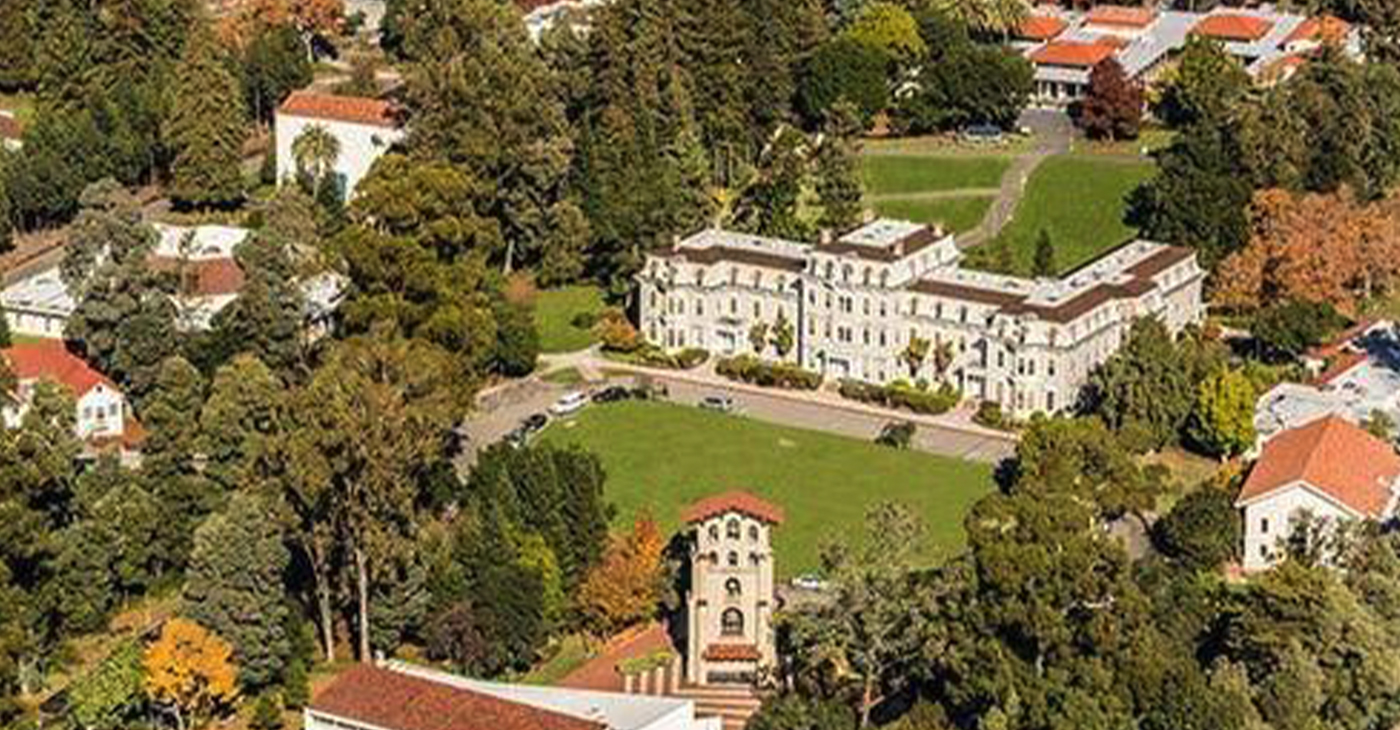Bay Area
Schaaf Administration Proposes Rezoning Former Mills College Campus to Allow Condos, Retail Development
“Meanwhile, Mills students have seen a drastic reduction in programs and workers are concerned that Northeastern has a history of union busting, and the community is concerned this will lead to their displacement,” said City Councilmember and mayoral candidate Sheng Thao, who attended Mills College.

By Ken Epstein | Post News Group
Buried in a draft plan for future housing in Oakland, submitted to City Council by Mayor Libby Schaaf’s Administration, is a map of zoning changes that would rezone the beautiful park-like 135-acre campus at what is now known as Mills College at Northeastern University to allow for private real estate development, including condominiums and retail, the Oakland Post has learned.
(Mills College officially merged with Northeastern University on June 30, 2022.)
The map is part of a presentation supplementing a 54-page draft Housing Element that was submitted for discussion to the City Council last week. The draft will be discussed and modified and scheduled for a vote in January. The City is required by the state to update its Housing Element every eight years as part of the City’s General Plan.
The map shows the entire Mills campus in East Oakland as changed from zoning designation “RM-4 Mixed Housing Type Residential – 4 Zone.”
According to the City’s definition, “The intent of the RM-4 Zone is to create, maintain, and enhance residential areas typically located on or near the City’s major arterials and characterized by a mix of single-family homes, townhouses, small multi-unit buildings at somewhat higher densities than RM-3, and neighborhood businesses where appropriate.”
City Council staff indicate that the RM-4 Zone would permit the development of the entire site with condominiums, townhouses and retail businesses.
The current zoning of the Mills property, RM-3 Zone, has been in place for at least the past 20 years, according to a staff member in the City’s zoning division. These changes are now in the works after Northeastern University in Boston recently took over the Mills campus, with pledges of a merger of many of the best aspects of both institutions.
At present, it is not clear what agencies or individuals requested the proposed zoning change, nor are there indications so far of how the property would be developed. In general, zoning changes are proposed by Council members in their districts.
Councilmember and mayoral candidate Loren Taylor, who represents District 6 where the campus is located, has been outspoken in support of the takeover of Mills by Northeastern.
Schaff has also been spoken forcefully in favor of the takeover of Mills by Northeastern.
According to an article in the Northeastern University (NU) newsletter, Taylor has been deeply involved in the merger discussions between the university and Mills.
“Taylor says he was involved in talks with the college and university as the merger evolved from idea to reality. ‘When I’ve had conversations with leadership at Mills and Northeastern,’ Taylor says, ‘I’ve always come away reassured. I hear, feel, and sense that there’s a true commitment to ensuring the legacy of what Mills had. I look forward to seeing that happen,’” the NU newsletter said.
By the Post’s deadline, neither Schaff nor Taylor had responded to questions about what the rezoning proposal means for the future of university education on the campus.
Although the proposal is to rezone the entire 135 acres of the campus, City staff told the Post that only part of the campus was being considered for development.
“The undeveloped western edge of the Mills College campus adjacent to MacArthur Blvd. was identified as a potential location for the addition of infill housing. Any rezoning of that portion of the campus would only occur if the community and decisionmakers support such a change and only for the purpose of facilitating the addition of housing along this undeveloped campus edge,” according to the City’s zoning staff.
Said City Councilmember and mayoral candidate Sheng Thao, “Recent changes in our zoning laws have raised alarm bells that this deal is nothing more than an attempt to turn Mills College into a plot of land for luxury condos. Developers stand to make enormous profits off that land.”
She continued: “Mills College is a 170-year-old institution and one of only two women’s colleges left in California. The shady backroom deals that led to its closure need to be investigated.”
“Meanwhile, Mills students have seen a drastic reduction in programs and workers are concerned that Northeastern has a history of union busting, and the community is concerned this will lead to their displacement,” said Thao, who attended Mills.
“I do not know why some of my colleagues rushed to embrace this deal, but I do know we need a fair and transparent process and an investigation from the state like I requested in July. The community deserves to know what is happening,” she said.
Rebecca Kaplan, Vice Mayor, and candidate for the Alameda County Board of Supervisors, told the Post she was also deeply concerned about what is happening to Mills. “The merger is suspicious and warrants an independent investigation,” she said.
The Council unanimously passed a resolution in July, introduced by Kaplan and Thao, calling for an “independent investigation into the circumstances of the merger between Mills College and Northeastern University.”
Mills College, a women’s institution, “is reflective of the region’s diversity,” according to the council resolution. “Within the 2021-2022 Mills student population, about 44% are first-generation undergraduate students and about 66% of undergraduate students are students of color.”
This investigation must be conducted because of “allegations of misconduct and misinformation (on the part of the Mills administration) ….to ensure that community needs are respected, truth is pursued, and that the important work of Mills in serving vital needs can be continued,” the Council resolution said.
Activism
Asm. Corey Jackson Proposes Safe Parking for Homeless College Students Sleeping in Cars
Assemblymember Corey Jackson (D-Moreno Valley), a member of the California Legislative Black Caucus (CLBC), is the author of AB 90, which would require community colleges and California State University campuses to create overnight parking programs where students can sleep safely in their vehicles. With one in four community college students in California experiencing homelessness in the past year, Jackson says the state must act urgently.

By Bo Tefu
California Black Media
As California’s housing crisis continues to impact students, new legislation, Assembly Bill (AB) 90, promises to allow college students without stable housing to sleep in their cars on campus, offering a stark but practical solution aimed at immediate relief.
Assemblymember Corey Jackson (D-Moreno Valley), a member of the California Legislative Black Caucus (CLBC), is the author of AB 90, which would require community colleges and California State University campuses to create overnight parking programs where students can sleep safely in their vehicles. With one in four community college students in California experiencing homelessness in the past year, Jackson says the state must act urgently.
“This just deals with the harsh realities that we find ourselves in,” he said at a recent hearing.
The bill passed its first committee vote and is gaining attention as housing affordability remains a top concern across the state. California rents are more than 30% above the national average, and long waitlists for student housing have left thousands in limbo. CSU reported more than 4,000 students on its housing waitlist last year.
Supporters stress that the bill is not a long-term solution, but a humane step toward helping students who have no other place to go. A successful pilot program at Long Beach City College has already shown that safe, supervised overnight parking can work, giving students access to restrooms, Wi-Fi, and a secure environment.
However, the CSU and community college systems oppose the bill, citing funding concerns. Critics also worry about safety and oversight. But Jackson and student advocates argue the crisis demands bold action.
“If we know students are already sleeping in their cars, why not help them do it safely?” said Ivan Hernandez, president of the Student Senate for California Community Colleges.
Activism
Faces Around the Bay: Author Karen Lewis Took the ‘Detour to Straight Street’
“My life has been a roller-coaster with an unlimited ride wristband! I was raised in Berkeley during the time of Ron Dellums, the Black Panthers, and People’s Park. I was a Hippie kid, my Auntie cut off all our hair so we could wear the natural styles like her and Angela Davis.

By Barbara Fluhrer
I met Karen Lewis on a park bench in Berkeley. She wrote her story on the spot.
“My life has been a roller-coaster with an unlimited ride wristband! I was raised in Berkeley during the time of Ron Dellums, the Black Panthers, and People’s Park. I was a Hippie kid, my Auntie cut off all our hair so we could wear the natural styles like her and Angela Davis.
I got married young, then ended up getting divorced, raising two boys into men. After my divorce, I had a stroke that left me blind and paralyzed. I was homeless, lost in a fog with blurred vision.
Jesus healed me! I now have two beautiful grandkids. At 61, this age and this stage, I am finally free indeed. Our Lord Jesus Christ saved my soul. I now know how to be still. I lay at his feet. I surrender and just rest. My life and every step on my path have already been ordered. So, I have learned in this life…it’s nice to be nice. No stressing, just blessings. Pray for the best and deal with the rest.
Nobody is perfect, so forgive quickly and love easily!”
Lewis’ book “Detour to Straight Street” is available on Amazon.
Activism
Barbara Lee Accepts Victory With “Responsibility, Humility and Love”
“I accept your choice with a deep sense of responsibility, humility, and love. Oakland is a deeply divided City,” Lee said in an April 19 statement. “I answered the call to run to unite our community, so that I can represent every voter, and we can all work together as One Oakland to solve our most pressing problems.”

By Antonio Ray Harvey,
California Black Media
As a candidate for mayor, former U.S. Representative Barbara Lee released a “10-point plan” last week to reassure residents that she will tackle Oakland’s most pressing challenges.
Now that she has edged out her competitors in the ranked-choice special election with 50% or more of the vote, the former Congresswoman, who represented parts of the Bay Area in the U.S. House of Representatives, can put her vision in motion as the city’s first Black woman mayor.
“I accept your choice with a deep sense of responsibility, humility, and love. Oakland is a deeply divided City,” Lee said in an April 19 statement. “I answered the call to run to unite our community, so that I can represent every voter, and we can all work together as One Oakland to solve our most pressing problems.”
On Saturday evening, Taylor conceded to Lee. There are still about 300 Vote-by-Mail ballots left to be verified, according to county election officials. The ballots will be processed on April 21 and April 22.
“This morning, I called Congresswoman Barbara Lee to congratulate her on becoming the next Mayor of Oakland,” Taylor said in a statement.
“I pray that Mayor-Elect Lee fulfills her commitment to unify Oakland by authentically engaging the 47% of Oaklanders who voted for me and who want pragmatic, results-driven leadership.”
The influential Oakland Post endorsed Lee’s campaign, commending her leadership on the local, state, and federal levels.
Paul Cobb, The Post’s publisher, told California Black Media that Lee will bring back “respect and accountability” to the mayor’s office.
“She is going to be a collegial leader drawing on the advice of community nonprofit organizations and those who have experience in dealing with various issues,” Cobb said. “She’s going to try to do a consensus-building thing among those who know the present problems that face the city.”
Born in El Paso, Texas, Lee’s family moved to California while she was in high school. At 20 years old, Lee divorced her husband after the birth of her first child. After the split, Lee went through a tough period, becoming homeless and having to apply for public assistance to make ends meet.
But destitution did not deter the young woman.
Lee groomed herself to become an activist and advocate in Oakland and committed to standing up for the most vulnerable citizens in her community.
Lee traveled to Washington, D.C. to work for then U.S. Congressman Ron Dellums after receiving a Bachelor of Arts degree from Mills College in Oakland in 1973. Lee later won a U.S. Department of Housing and Urban Development (HUD) fellowship to attend the School of Social Welfare, and she earned a Master of Social Work from the University of California-Berkeley in 1975.
Lee later served in the California State Assembly and State Senate before she was elected to Congress in 1998.
After serving in the U.S. Congress for more than 25 years, Lee ran unsuccessfully for California’s U.S. Senate in the 2024 primary election.
Lee joins current Los Angeles mayor Karen Bass and former San Francisco Mayor London Breed as Black women serving as chief executives of major cities in California over the last few years.
-

 Activism4 weeks ago
Activism4 weeks agoOakland Post Endorses Barbara Lee
-

 Activism3 weeks ago
Activism3 weeks agoOakland Post: Week of April 2 – 8, 2025
-

 #NNPA BlackPress3 weeks ago
#NNPA BlackPress3 weeks agoTrump Profits, Black America Pays the Price
-

 Activism2 weeks ago
Activism2 weeks agoOakland Post: Week of April 9 – 15, 2025
-

 #NNPA BlackPress3 weeks ago
#NNPA BlackPress3 weeks agoHarriet Tubman Scrubbed; DEI Dismantled
-

 #NNPA BlackPress3 weeks ago
#NNPA BlackPress3 weeks agoTrump Targets a Slavery Removal from the National Museum of African-American History and Culture
-

 #NNPA BlackPress3 weeks ago
#NNPA BlackPress3 weeks agoLawmakers Greenlight Reparations Study for Descendants of Enslaved Marylanders
-

 #NNPA BlackPress3 weeks ago
#NNPA BlackPress3 weeks agoNew York Stands Firm Against Trump Administration’s Order to Abandon Diversity in Schools




















































